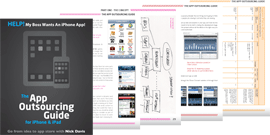Why have I produced a guide only for iPhone or iPad apps when they’re not even close to having the biggest share of phones/devices in any market? I’m certainly not an ‘Apple-phile’ (this guide was written in Google Docs on a Sony Vaio PC running Windows(!)) and I’m not totally dismissive of other platforms, but right now although iPhone/iPads aren’t quite the only game in town, they should certainly be your first stop (unless you have a very compelling case for targeting a particular audience that tends to favour a single device, eg Blackberry).
As this moment, despite the rising number of Android devices (‘Android to Become No. 2 Worldwide Mobile Operating System in 2010’) (currently seen as the main rival to Apple’s App Store platform despite efforts from Blackberry, Nokia and Windows) in terms of app numbers and awareness Apple’s app platform is still considered number one for apps themselves (‘Apple’s App Store said to have 99.4 percent of all mobile app sales, more like 97.5’). Even more so with the injection of interest that the iPad platform has given it (particularly for publishers – and I’ve seen some publishers very animated about the potential of the iPad).
That is not to say these other devices aren’t or won’t be increasingly important, they already have, or are gaining, huge numbers of users (‘Android Most Popular Operating System in U.S. Among Recent Smartphone Buyers’ Huffington Post‘). It’s just a reflection of the market right now.
It is just one slice of data among many, but it is interesting to note that on Mashable.com (the leading social media news website which gives a lot of positive coverage in general to Android apps) in 2010 the comparison of users of it’s mobile apps read:
- iPhone & iPod Touch: 152,000+ users
- iPad: 104,100+ users
- Nexus One, Droid, Incredible (all types of phones running the Android operating system): 9,400+ users
We could look at figures forever more and they won’t give us anything conclusive, so I think the main point to take away is that when you say ‘app’ to most people (non-developers at least) right now the very next thing most will think is iPhone (or maybe iPad) rather than a generic term (mobile) or another brand (Blackberry,Android). This is not to dismiss other platforms (I’m incredibly excited to see how things pan out) that’s just how things are at this moment.
If you want to develop apps for several platforms in parallel that can still be done (and there’s a couple of options for that we’ll come on to later). Or, if you want to do your iPhone App first you can always use it as your template for apps on other platforms as you go along. In any case, as you can see from the following figures, Apple’s mobile users should be more than enough to get your teeth into for now:
- iPhones sold to date = 50,000,000+
- iPads sold to date = 3,270,000 (‘Apple Reports Third Quarter Results, 22 Jun 2010‘)
- Apps downloaded = 6.5 billion (‘Statement by Apple on App Store Review Guidelines, 09 Sep 2010‘)
- Apps in App Store = 280,000 (30,000 of which are iPad apps) (‘Apple’s iPad Coming to AT&T Stores on October 28, 14 Oct 2010‘)
Now if that all sounded great until the last stat (280,000 apps) and you’re thinking ‘how do I ever compete with all those apps’, then help is at hand in this guide and with the knowledge that:
- Firstly, a lot of those apps are of low quality simply because their creators made some easily avoidable mistakes (with the help of this guide you will avoid many of these and give yourself a much better chance of producing a great app first time around).
- Secondly, a lot of those app producers do not have any clear goal or understanding of their audience (by doing some simple research and organising your ideas in the right way you’re not going to make that mistake).
- Thirdly, a lot of the creators of those apps have no clear marketing strategy or realise that half the battle is not just putting something out of high quality, it’s having an excellent promotional strategy too (this guide has over 50 ideas for promoting your app, many of which cost absolutely nothing).
If you’re interested to learn more about mobile data and trends you can find more via:
You can also browse the following research firms websites for their latest reports:
